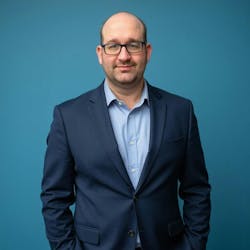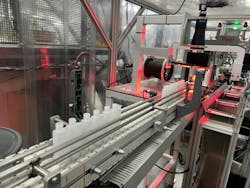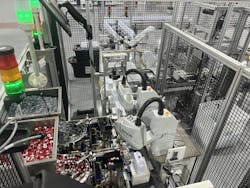By Robert Grace
Currier Plastics, in its colorful history, has excelled at adapting to changing times. Founded by Raymond Currier in 1982 with a pair of used injection molding machines in Auburn, N.Y., the company started up in 8,000 square feet of a pre-1922 building that had been occupied by the nation’s largest maker of cordage rope, the Columbian Rope Co.
Ray had been working as an engineer at Auburn Plastics, which began life making shellac buttons. In the early 1980s his son Jim urged him to launch his own molding business.
In a recent interview, Ray McKee, the company’s director of manufacturing, recounted the path forged by Currier Plastics, which has led to it being named the recipient of this year’s Recognition of Excellence Award by SPE’s Blow Molding Division. The company will be honored at the Annual Blow Molding Conference Sept. 8-10 in Pittsburgh.
The firm was just a year old when another of the founder’s sons, John, joined the operation as its fifth employee. Four years later, in 1987, 27-year-old John became president — a post he still holds today.
Seeking a way to stand out
From the company’s early days as a custom injection molder, John sought ways to differentiate the company from other manufacturers. Around 1996, Currier was injection molding the cap for a small hotel amenity bottle when the company blow molding the bottle had a disagreement with its customer. A Currier employee saw an opportunity and came to John to urge him to dive into the blow molding business. John agreed, so Currier bought a used blow molding machine and began to offer both caps and bottles in the hotel amenity sector.
Blow molding was challenging at first, McKee said, but the company persevered. The company built a significant customer base over the next several years.
The amenity bottles Currier was making were typically for 1.5 to 3 ounces of lotion or shampoo, and were giveaways in many hotels. The company extrusion blow molded most of them out of HDPE and injection stretch blow molded the balance out of PET.
The firm bought its first extrusion blow molding (EBM) machine in 1996 and added injection stretch-blow molding (ISBM) — a new Aoki machine — in 2009. By 2018, the company was producing more than 1 billion of these products (bottles and caps combined) per year.
Currier’s blow molding business continued to pick up steam. In 2012, Currier added 40,000 square feet to its facility in Auburn, and devoted it entirely to blow molding.
The company had deep relationships with three of the major hotel amenities supply companies in North America, and estimates that in 2019 it had roughly a 65 percent share of custom bottles and caps for these single-use personal-care packages. At that time, that accounted for 40 percent of the firm’s overall business.
But then a sustainability-related reality reared its head, as a wave of sentiment against single-use plastics prompted lawmakers across many states to introduce legislation banning these tiny bottles.
It began using EBM to mold refillable, wall-mounted bottles for hotel use –– mostly in sizes from 9 to 15 ounces — but some competitors were able to produce these as stock PET bottles. Currier doesn’t like making round bottles much and tends to avoid molding stock products, as it prefers to focus on value-added custom container work.
Pivoting toward health care
The company had to adjust and as of 2016 or so had already begun to reassess its strategic focus. It chose to target the health-care sector. It hired a veteran of that space, Ron Ringleben, to serve as VP of business development. And in 2019 it built its first clean-room facility, covering 9,000 square feet, in its original plant on Columbus Street.
In August 2017, Currier hired McKee as its director of manufacturing, overseeing “anything operations-related,” he said. “I never did blow molding until I came to Currier.”
McKee studied plastics engineering at Penn State Behrend. He previously worked for Owens-Illinois and for Rexam before those businesses were acquired by Berry Global. At Berry, he oversaw production of thermoplastic compression molding and injection molding operations before joining Sonoco Products in North Carolina in July 2014. He has served more than 17 years as a director for SPE’s Injection Molding Division.
Currier turned its sights firmly on the medical market, in particular, highly engineered, technical containers. “We heavily participate in the in-vitro diagnostics market, doing reagent containers for those diagnostics machines,” McKee said.
These types of products typically have unique features. For example, some feature dual chambers molded from a single parison, or top and bottom blow, or may look more like a cartridge than a bottle.
As the company moved into that sector, McKee says he felt the pull to personally get more involved on the engineering side. He dove deeply into blow molding starting in about 2021.
Currier upgraded to a medical-conforming ISO 13485 quality system and hired some more engineers experienced with the health-care sector. In early 2023, the firm remodeled and opened its second facility in Auburn, about a mile from the headquarters plant. With just over 63,000 square feet of space, that newer plant features a 25,000-square-foot ISO-8 clean room.
In Europe and North America, at least, McKee said, “We are one of the few custom molders that are doing extrusion blow molding in a clean room.”
A large stable of machines
Currier today employs just more than 200 people, with an estimated 70 percent or so of them focused mostly on blow molding. It operates a total of 60 machines, including about 28 blow molding machines.
It operates nine all-electric blow molding machines, including from Magic, Kautex and Bekum. It also runs eight hydraulic Aoki ISBM machines. In 2021, the company purchased its first injection blow molding (IBM) machine.
During COVID-19, Currier kept operating. “I never missed a day in the plant,” McKee recalled. Just before the pandemic hit, the company had been planning an aggressive, 90,000-square-foot expansion of its original facility. “And then,” he said, “literally the world shut down” due to the pandemic.
At that time, some 40 to 45 percent of the firm’s business was still focused on hotel amenities. When the pandemic hit, hotels stopped buying. Rather than sit and wait for that business to rebound, Currier stepped up its health-care activity.
“We had spare capacity, and we were able to build molds and turn around products pretty quickly,” McKee recounted. So, in 2020 and 2021, Currier did more new-product development than it had done in any previous five-year period. “That really started to drive our health-care growth,” which today accounts for roughly 60 percent of the company’s business. In 2016, that figure was less than 1 percent.
Impressive sales growth
Today, hotel amenities account for only about 5 to 8 percent of Currier’s business. The firm’s revenue has continued to grow. It registered sales of $35.5 million in 2017 when McKee joined the company, and today it has projected revenue for 2025 of $60 million, he said.
Currier needed more space to accommodate this growth. A lot of its activities focused on the more technical aspects of such tasks as automation and assembly. “We looked at building that 90,000-square-foot addition again, but the post-COVID price had gone up by, like, 60 percent,” to more than $14 million, he said. So rather than build a new facility, the firm’s leaders decided in July 2022 to acquire a facility that had just come on the market, completely renovate it, and build a large clean room inside it.
“Our business is much more now about, ‘How do we automate the product?’ We have several six-axis robots, do serialized bar coding, and apply a rubber plug and a metal crimp to the bottles with bowl feeders and SCARA robots,” McKee said.
Many of these products are pallet-to-pallet with no humans ever touching them. Currier builds vision systems with five to seven cameras to provide customers with 100 percent product inspection. Currier also has a range of packaging automation, including a semi-automatic double-bagging system it developed together with Dyco Inc. and a custom palletizer where parts get palletized on a custom thermoformed tray before being stacked by a larger robot. Currier ships products straight to the customer that way.
Besides health-care products and hotel amenities, the company makes packaging for the food, beverage and personal-care markets.
Automation remains key
Health care will remain the focus. “As we look at developing technology and talent, it’s more around the automation value-add services and more of the technical engineering behind these more complex products,” McKee said.
To date, Currier Plastics’ operations have all been centered in upstate New York. Customers have asked the firm about replicating its approach in Europe, and McKee said company executives have discussed it. Such expansion remains a possibility. He also noted that major customers have concentrations on the coasts, and that Currier recognizes it would be easier to serve West Coast clients if it had a presence there.
“We’re still working on filling up the building we just bought,” which opened in 2023. It’s currently about 60 percent full. “We still have some capacity we could fill in the equipment that’s there.” The space exists to add several more machines at that site when needed, he said.
In mid-June, Currier had just finished installing a new Bekum machine — an all-electric with a 400mm stroke. And, noted McKee, other new automation lines are coming soon. As an all- custom business, he said, Currier adds capacity only when new business dictates.
Partnering to advance sustainability
When it comes to sustainability, Currier is limited in what it can do to reduce material use in its products, but the firm uses post-consumer recycled resin in many of its products for the packaging market and has scored some wins by focusing on packaging and logistics. It has done projects with two of its health-care customers to adopt reusable packaging, which has served to increase the bulk density of products in the trucks, allowing it to ship more product in the same amount of space.
The company developed a customized thermoformed tray for palletizing products it ships to one customer, eliminating the previously used cardboard boxes and plastic bags. “Now we ship everything on these thermoformed trays, they return them, and we ship them again — and we increase the density of the truck by about 35 percent.” The customer has been using those returnable trays for more than a year now, McKee noted.
Additionally, the company used to ship some products on general heat-treated pallets, but a customer explained that it ships all its products out on a specific type of pallet. So Currier adopted the same pallet for shipping to the customer, again enabling its reuse by the customer.
The company has also worked with its local utility companies and, as a result, currently gets more than half of its energy from renewable solar and hydro sources.
Now in its 43rd year, Currier Plastics continues to evolve and adapt to changing customer demands, political influences and market trends. That flexibility and vision have helped it not only to survive but thrive. The SPE Blow Molding Division is pleased to recognize these accomplishments with its latest honor.
This article appears in the summer 2025 issue of The Journal of Blow Molding.
© 2025, Society of Plastics Engineers Blow Molding Division
About the Author
Robert Grace
Robert Grace is editor of The Journal of Blow Molding.




